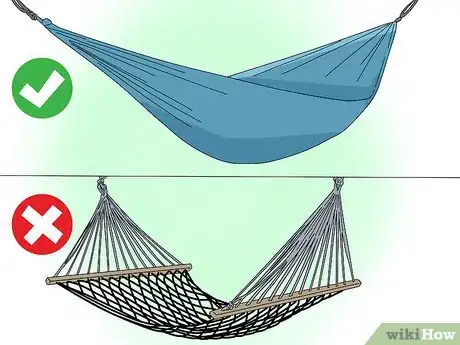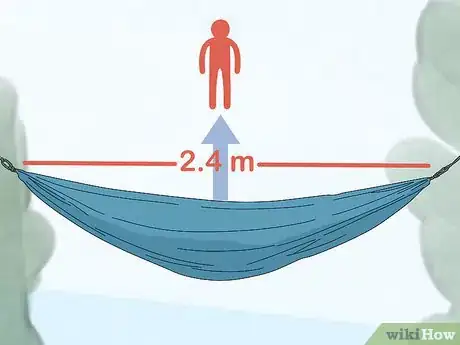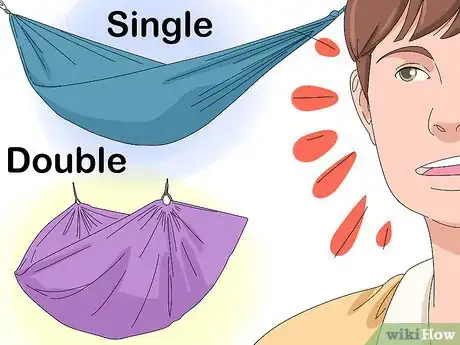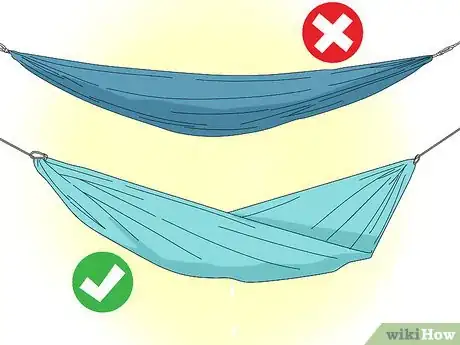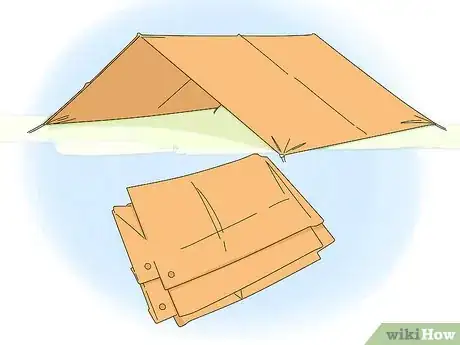This article was co-authored by wikiHow Staff. Our trained team of editors and researchers validate articles for accuracy and comprehensiveness. wikiHow's Content Management Team carefully monitors the work from our editorial staff to ensure that each article is backed by trusted research and meets our high quality standards.
This article has been viewed 49,643 times.
Learn more...
Sleeping in a hammock isn’t just for a fun day at the beach or a night out among the stars; it can also be good for your health. The gentle rocking motion of a hammock, as well as the floating support of the material, can make for longer, deeper sleeps. Start by choosing a hammock that fits your height and weight. Then, set up the hammock properly and lay down at an angle to ensure you get a good night’s sleep while camping, at the beach, or chilling out at home.
Steps
Selecting the Hammock
-
1Get a hammock made of nylon. Look for hammocks made of parachute nylon, as they will be the most comfortable to lay in for a long period of time. Avoid hammocks made of rope or slats, as they can cause discomfort and rope burns.[1]
- You can buy parachute nylon hammocks at your local outdoors store or online.
-
2Choose a hammock that fits your height and weight. Hammocks come in small, medium, and large sizes that vary in width and length. In general, a wide, long hammock is more comfortable. If you are tall, look for a hammock that is at least 8 feet (2.4 m) long. Get a large or extra large sized hammock if you are a larger person and need more room.[2]
- When in doubt, opt for a wider, larger sized hammock, as you do not want to overload a hammock that is too small and risk it ripping or falling down.
Advertisement -
3Decide if you need a single or double hammock. If you plan to sleep alone in the hammock, you will need a single. If you plan to sleep with more than one person in the hammock, go for a double so you have enough room.[3]
Setting up the Hammock
-
1Hang the hammock between 2 trees at least 12 to 15 feet (3.7 to 4.6 m) apart. Make sure the trees or poles are sturdy and will not move or sway due to wind or weather. Use hammock rope and wide webbing or bungee cords to secure the hammock to the poles.[4]
- Check that there is a 30-45 degree angle between the hammock line and the tree or pole. This will ensure the hammock hangs properly.
-
2Check that there is a deep curve in the hammock. The hammock should not be suspended too tight, as this can make it difficult to relax in while you sleep. When in doubt, make the hammock loose, with a deep curve from pole to pole, so it hangs at least 12 to 18 inches (30 to 46 cm) from the ground.[5]
- The deep curve will also ensure the hammock fabric does not become too loose, causing you to get caught up in the material while you sleep.
-
3Put a pillow and a blanket in the hammock for comfort. Treat the hammock like a bed and include comforting details like a small pillow and a warm blanket. You can also have an extra pillow on hand to elevate your knees if you want more lower back support.
- If you are sleeping outside in the hammock, you should wear warm sleeping clothes like long underwear, socks, long sleeves, and a hat.
-
4Have a tarp on hand for protection from wind and rain. If you are sleeping outside in the hammock, make sure you have a weatherproof tarp within reaching distance of the hammock. You can then lay the tarp over the hammock to protect it from getting wet or battered by the wind, as needed.[6]
Getting a Good Night’s Sleep
-
1Sit down in the middle of the hammock. Getting into a hammock can be done easily by sitting down in it butt first so your weight is distributed evenly in the center. Then, slide your legs and upper body into the hammock.
-
2Lay down diagonally on your back, slightly off center. Position yourself at an angle on your back so your body makes a diagonal line in the hammock. This will ensure your weight is well supported in the hammock and prevent you from sinking too deeply into the material.[7]
-
3Slide up or down on the hammock until you feel cradled by the fabric. To prevent your head from rolling too far left or too far right, try sliding up or down until your head feels supported. You may need to slide up on the hammock so your head is closer to the edge or down so your legs are closer to the edge. Take some time to find a spot on the hammock in a diagonal position that is comfortable for your head and neck.[8]
- If your head and neck still do not feel supported, you can slide a pillow under your head. However, the curved shape of the hammock should make it easier for your head and neck to rest comfortably.
-
4Place a pillow or a rolled up blanket under your knees to protect your back. If you tend to have lower back issues, slide a thin pillow or a rolled up blanket under your knees when you are in the hammock. This will ensure your back is well supported while you sleep.[9]
- If you do not have a pillow or rolled up blanket handy, you can try crossing your legs at the ankles to protect your lower back. However, you may find it tricky to maintain this position while you sleep.
-
5Wrap yourself up in the hammock fabric or a blanket to stay warm. If the hammock has extra fabric on either side, wrap it around you so you are cocooned in the hammock. You can also wrap yourself in a blanket to stay warm throughout the night.[10]
- Alternatively, you can line the hammock with a blanket before you lay in it so you stay warm on the back and front side of your body while you sleep.
- If the weather is going to be very cold for the night, you may lay a sleeping bag over the hammock to stay extra warm.
References
- ↑ https://www.digitaltrends.com/outdoors/best-camping-hammocks/
- ↑ https://www.digitaltrends.com/outdoors/best-camping-hammocks/
- ↑ https://www.digitaltrends.com/outdoors/best-camping-hammocks/
- ↑ https://theultimatehang.com/2012/07/03/hammock-camping-101/
- ↑ https://hikingcampingguide.com/how-to-sleep-in-a-hammock-properly/
- ↑ https://theultimatehang.com/2012/07/03/hammock-camping-101/
- ↑ https://hikingcampingguide.com/how-to-sleep-in-a-hammock-properly/
- ↑ https://youtu.be/qAxsU0rQZ_M?t=137
- ↑ https://hikingcampingguide.com/how-to-sleep-in-a-hammock-properly/
About This Article
Sleeping in a hammock can take a little getting used to, but with the right position, you can get a great night’s sleep. You’ll want to lie on your back diagonally across the hammock so it will properly support your weight. Try sliding up and down until your head and neck feel supported. The curved shape of the hammock should make it comfortable enough, but you can use a pillow if you want. If it’s likely to get cool during the night, lay a blanket down before you get in the hammock and wrap it around yourself to keep your whole body warm. If you tend to have lower back issues, place a rolled up blanket or pillow under your knees to help support your back. For more tips, including how to set up your hammock, read on!
